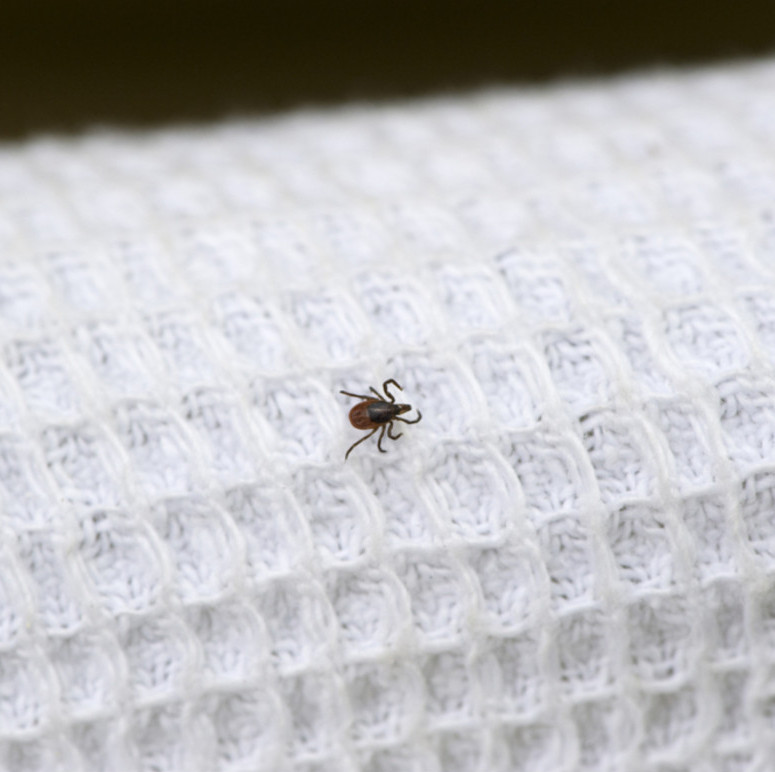![]()

The Department of Health and Human Services recognizes May as Lyme Disease Awareness Month. As the spring and summer months are the primary tick season in Nebraska, DHHS urges all residents to be mindful of ticks and to share information with their community on how to stay safe. Common tickborne diseases include Lyme disease, Ehrlichiosis, Rocky Mountain Spotted Fever, Alpha-Gal Syndrome, and Tularemia.
Ticks are small arachnids that feed on blood and have the potential to transmit and spread serious diseases to both people and pets. They can typically be found in or along brushy, wooded, or grassy areas. Quick removal of any attached ticks (particularly within 24 hours) greatly reduces the chances for a tick to transmit disease.
Lyme disease is a bacterial infection that is transmitted through the bite of an infected tick. Early signs and symptoms include fever, chills, headache, fatigue, muscle and joint aches, and swollen lymph nodes. In approximately 70 to 80% of infected persons, an erythema migraine rash (bulls-eye rash) is present at the site of an infected tick bite. If left untreated, late signs and symptoms can include severe headaches, stiff neck, facial palsy, arthritis, heart palpitations, and nerve pain.
According to the Office of Epidemiology Vector-Borne Program, Nebraska had 14 reported cases of Ehrlichiosis in 2023. Ehrlichiosis is a broad name used to describe several related bacterial diseases that affect animals and humans. The first symptoms will usually begin within two weeks after the bite of an infected tick. Symptoms include fever, headache, chills, muscle pain, fatigue, gastrointestinal distress, altered mental status, and rash. If Ehrlichiosis is suspected, treatment should never be delayed.
Rocky Mountain Spotted Fever symptoms typically begin 2-14 days after a tick bite. Symptoms include fever, headache, nausea, vomiting, lack of appetite, muscle pain, abdominal pain (may mimic appendicitis), conjunctival injection (red eyes), rash, cough, sore throat, and diarrhea. If infection with Rocky Mountain Spotted fever is suspected, treatment should never be delayed and should start within the first five days.
Alpha-Gal Syndrome may be triggered by the bite of an infected tick which can lead to red meat allergies. Symptoms include hives or itchy rash, gastrointestinal distress, heartburn, cough, shortness of breath, swelling of lips, throat, tongue, or eyelids, dizziness, or severe abdominal pain. Treatment should be managed by an allergist or other healthcare provider.
Tularemia can be found in animals and humans transmitted through contact with infected animals or an infected tick bite. Symptoms include fever, skin ulcers at the infection site, and swollen lymph glands.
Tickborne diseases are diagnosed by a medical professional based on clinical signs and symptoms, the patient’s recent activity, and confirmed with a laboratory test. With an early diagnosis, patients can be treated with an appropriate antibiotic. Patients in later stages may require more extensive treatment.
Tips to stay safe:
- Wear light-colored clothing to make ticks easier to find. Tuck long pants into socks and boots.
- Apply an Environmental Protection Agency-registered insect repellent containing 20% DEET, picaridin, IR3535, or Oil of Lemon Eucalyptus according to label directions.
- Treat clothing and gear with products containing 0.5% permethrin. Permethrin can be used to treat boots, clothing, and camping gear. It remains protective through several washings.
- Walk in the center of the trails. Avoid wooded, brushy areas with high grass and leaf litter.
- Conduct full-body tick checks (underarms, ears, belly button, behind knees, between legs, waist, hair, and scalp) every two to three hours.
- Pets should also be checked for ticks after being in areas where ticks might be found. Be sure to also protect pets using a tick prevention program through your veterinarian.
- Put your clothes in the dryer on high for 10 minutes (or one hour for damp clothes) to kill ticks.
- Shower within two hours after coming indoors.
- Learn about tick removal and symptom awareness.
- If you become ill with fever and/or rash after being in an area where ticks may have been, contact your healthcare provider.
- Visit the NDHHS Vector-Borne Disease website for additional information: https://dhhs.ne.gov/Pages/Tick-Borne-Diseases.aspx
A great resource to help residents learn about tick species and the diseases they can pass on is the Nebraska Tick Surveillance Map. This map is an interactive tool that documents the counties in Nebraska where different tick species have been found and what diseases they are carrying.
